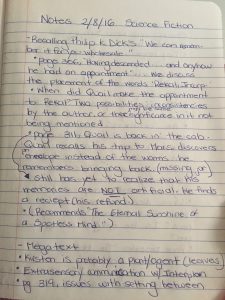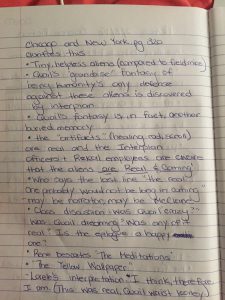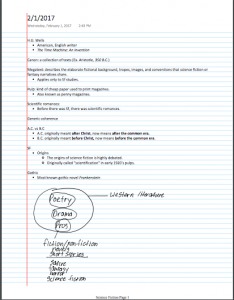Category Archives: Class Notes
March 13, 2017 Class Notes: Preparing for the Midterm, Monday, March 20
Preparing for the midterm exam:
- Review Course Notes (both those posted and those you have taken)
- Review your assignments
- Re-read the “Introduction” to the Wesleyan Anthology of Science Fiction and The Science Fiction Encyclopedia entry “Definitions of SF”
- Prepare study cards for each story that we have read in the context of the elements of fiction and SF keywords, themes, and issues
Our midterm exam will consist of two parts: 1/ some short definitional questions of Literary and SF Keywords; 2/ two short essay questions, i.e., three paragraphs each, each asking you to do a close reading of a passage from a text or to discuss some attribute of or theme of a text in the context of other texts that we have read
What we have read so far:
“We Can Remember It For You Wholesale” (1966) by Philip K. Dick
“Day Million” (1966) Frederick Pohl
“The Second Inquisition” (1970) by Joanna Russ
“Time Considered as a Helix of Precious Stones” (1969) by Samuel Delany
“About 5,750 Words” by Samuel Delany
“There Will Come Soft Rains” (1950) by Ray Bradbury
“Reason” (1941) by Isaac Asimov
“Fondly Fahrenheit” (1954) by Alfred Bester
“Helen O’Loy” (1938) by Lester Del Rey
Common themes and concerns:
1/ there is some confusion or disorientation at the beginning of the story that is generally cleared up by the end
2/ all of the stories deal in some way with advanced technologies
3/ all of the stories are concerned in some way with the fate of humanity
4/ all of the stories try to guess what the future will look like
5/ all of the protagonists are affected or impacted by technologies
6/ many of the stories deal in some way with the relationships between humans and machines and/or nature and culture/society
7/ All of the stories are interconnected. The authors write in response to the themes, characters, plots, and settings of other authors
Some key discussion questions:
1/ What will be/is the fate and/or role of humanity in a world of endless technological progress?
2/ Are humans inferior machines?
Sample midterm exam questions:
Section 1: Definitions of Keywords and Terms
Sample question:
Genre
Definition:
Why the term is important in SF studies:
Section 2: Three paragraphs about some particular element of a story we have read [see elements of fiction]: setting, plot, character, theme, narrative point of view, figurative language/style
Sample question:
The way in which a story is told often helps to develop the meaning of the story. Consider the narrative points of view in ONE of the stories we have read.
Section 3: One page (three to five paragraphs) on a more open-ended question related to the study, reading, and interpretation of SF
Sample question:
Write about two different characters from two different stories that we have read. Compare/contrast these characters and reflect on what their similarities/differences may have to say about the characteristics of sf in the era in which they were written.
Class Notes, March 8 (Yamit Benamu)
March 6, 2017: Class Notes
March 6, 2017
It is a fiction about a robot gaining consciousness. [see Professor Rodgers’ handout: “Writing About Texts”]
“Reason” by Isaac Asimov is a short story. It is about …
There are these two engineers who are living inside a ship and they need to keep the reactor going. They get a new robot and they put it together and it is like an advanced robot. HOw do they put it? The robot’s name is QT, also called “Cutie.” So they tell QT that they made him and his purpose is to serve them, but QT does not believe it. So QT goes off and develops his own story about how he was created, which is the reactor, i.e., the Master created him, to serve the master and the humans in there are inferior and they need to go and now he is in charge and blah, blah, blah.
This story is about a robot gaining consciousness and achieving his beliefs. Setting: space station? Year?: 2058 A.D. Main characters: Mike Donovan, Gregory Powell, QT-1, The Master, other robots, Franz Muller, Sam Evans
The story is about engineers and a new robot. QT thinks he is smarter than the engineers. QT makes all of the robots follow him. He does not believe that beings and planets are
The story is about two engineers that constructed a robot whose logic contradicts the logic of their reality. The conflict is whether or not the robot can complete its purpose based on its beliefs or the reality.
QT-1 believes that human beings are not important. They die fast and they are expendable.
Destiny (video game)
TV show: Dr. Who (“The Ood”): alien race made to serve
“Reason” by IA is a short story set in the year 2058AD. The robot that they have constructed gains consciousness and believes that it the humans that built him did not really build him. Therefore, he develops his own beliefs and that the converter is his one true creator and his one purpose in life is to serve him/her/it.
Narrator: third person omniscient
Can you read Bester’s “Fondly Fahrenheit” as a continuation of Asimov’s “Reason”? Why? In what ways may it be a commentary on Asimov’s “Reason”?
March 1, 2017 Class Notes
Ray Bradbury, “There Will Come Soft Rains” (1954)
What: Bradbury, Ray. “There Will Come Soft Rains.” Collier’s, 1950.
Objective, third person narrator who is unnamed and may or may not be human. Some possibilities include: The house? A surveillance system? A survivor? A “nanny cam”? A security system? The robots?
Characters: four people: Mrs. McClellan, her husband and two children. There is also a dog and nine thousand robot attendants. A Mr. Featherstone is mentioned. We don’t know who he is, but it is his birthday.
Did the house live? Did the house die? Is the house destroyed?
Is the house the narrator? Why or why not?
Why are there robot mice?
Narration: highly objective, precise, quantitative, all seeing, all knowing, stylistically the narration reads as some kind of report,
Diction: highly factual
Clocks: time, order, end of things, Doomsday Clock,
Elon Musk lives in a smart house.
Why would the author or narrator have chosen the “interior of a clock shop at midnight” as an image for the last section of this story?
Cogs are still in motion in a clock shop, despite being no one to attend to, clocks still function, clock shop would be loud at midnight (sounding alarms), “end of time/end of times”, new beginning, midnight is when both hands overlap and it is simultaneously the beginning and end of a day.
How do we define and organize time?
Is this story about time travel?
“Day Million” by Frederick Pohl
“We Can Remember It For You Wholesale” by Philip K. Dick
“Time Considered as a Helix of Semi-Precious Stones” by Samuel Delany
“The Second Inquisition” by Joanna Russ
Compare/Contrast: all of the stories we have read deal with the future of humanity; utopia/dystopia; utopic/dystopic
Humans can disappear, but time continues. “There Will Come Soft Rains” is a story about time. It is structured by time,
In what way is the Teasdale poem a metonym for the story?
Nature is ultimately more powerful than technologies in this story.
Time is relative!
Technologies appear to improve with time. But are also irrelevant without people to use them. Technologies may breakdown. They may also post-date humans.
Class Notes: February 22, 2017
We will be finishing up our discussion of Delany’s essay and short story next Monday. At that time, we will also discuss the excellent contributions to the SF Keywords definitions. I encourage you to read/re-read Delany’s essay and story, the notes below, the Delany posts, and the SF Keywords posts before our class next Monday.
February 22, 2017
“Time Considered as a Helix of Semi-Precious Stones” by Samuel Delany, which was published in the late 1960s, is a short story. The main character is a middle-ranked reluctant thief who simply wants to make a better living. HCE are the initials used consistently in the multiple names and identities attached to the protagonist and narrator. HCE as a woman meets Maud, who is an agent and wearing the stone of Jasper, which is a word, and he is not sure if he should approach her or not. Set in the future, in year –75 (space travel to Triton and Mars, three subways in NYC, three dimensional imaging/holographs, at least 500 years into the future (237)). Arty, Maud, Singer, HCE (at least three separate characters: the orphan boy named Harold Claney Everett growing up on a farm in Vermont, the small time crook named Hank Culford Eccles, the woman in the high heels named Harmony C. Eventide, big time Hector Calhoun Eisenhower. Ending appears to be unclear; no big finale. Consistent limited first person narrator. Most of the story takes place in a future NYC.
- 256: The whole plotof the story appears to be reflected in this passage because throughout the story, Maud has a problem with HCE becoming a big boss. Maud wants only one top level boss and many lower level thieves.
Crime does pay
Space travel
Digital imaging technologies
Questions:
1/ Why are the rising people the most dangerous?
2/ Why are the Singers so important?
3/ If HCE is always immersed in his new identities, how/why is he found?
“About 5, 750,” published in 1969? is an essay about how you can use different words to express the same thing and claims that there is no separation between style and content in fiction. The change of a single word in a 700 page novel could be important (2). Delany also emphasizes how each word revises the context of the words the precede it. Word choice matters to build up a story.
- 3:
D
Why might Delany’s style be important for writers and readers? 1/ For example, how might Delany’s ideas about writing influence other writers? How might they influence and affect readers?
2/ Is Delany’s style/ideas used by other science fiction writers/other fiction writers?
3/ How do you think the “structure” of someone’s writing affect the reader.
In “About 5, 750 Words,” D. argues that one’s choice of words matters. In “Time Considered a Helix of Semi-Precious Stones,” he appears to be putting into practice some of his ideas in “About 5, 750 Words.” It is important to notice the passage on p. 222.
What is the significance of the Singers?
What does the title mean?
Group Work: Delany February 22, 2017
Story: Yaya, Kyle, Giovanni, Lorelei (DF), Robert, Oni (GF), Andy
Essay: Ermis (DF), Vlad (GF), Jonathan, Santos, David, Edwin, Josh
Connections: Hussein (GF), Joseph (DF), Michael, Noshin, Jose, Miquel, Sali, Dorian
How To Approach a Text: Guidelines for Textual Description, Analysis, and Interpretation
What? [title, author, date, narrative perspective (s), plot synopsis, characters, themes, genre(s), publication history]
How? [how is it structured? sections? acts? argument? references?]
Why? [what may the title mean? why is this text interesting and important in the context of the author’s work and in the context of sf studies generally? what questions does the text raise? What is unique about it?]
Select one short passage for us to discuss together. [why this passage?]
So What? [3 Discussion Questions for the Class]
Course Questions: Wednesday, Feb. 15, 2017
- How do you define verisimilitude? [see SF Keywords post] / http://www.wwnorton.com/college/english/litweb10/glossary/V.aspx
2. Are canon and megatext synonyms? If not, how do they differ? Are they related? [see SF Keywords post and http://www.wwnorton.com/college/english/litweb10/glossary/C.aspx ]
3. How many reading journal entries should we have by now? [We are in week three of the semester, therefore, you should have at least three. However, we have read and responded to seven texts: the Wesleyan “Introduction,” “Why Do You Read Science Fiction?,” Dick’s story, Pohl’s story, Russ’s story, Delany’s story, and Delany’s essay. You may have reading journal entries for each of these texts, in which case, you’ll have seven entries.]
4. How do you define “the Golden Age” of Science Fiction? What are its characteristics? [see SF Keywords post]
5. How do you define “Next Wave” or “New Wave Science Fiction”? [see SF Keywords post]
6. How do you define novum? [see SF Keywords post]
7. How do you define cybernetic? What was the definition in 1950? What is the definition today? [see SF Keywords post]
8. In Frederick Pohl’s story “Day Million,” is the character Don a robot, or is he an augmented human?
9. Is time travel a theme? [The simple answer is: “yes.” However, the more complicated answer is much more complicated. Take a look at the SF Encyclopedia entry for a sense of the complications involved: http://www.sf-encyclopedia.com/entry/time_travel and the Norton LitWeb for a working definition of theme: http://www.wwnorton.com/college/english/litweb10/glossary/T.aspx]
10. What is the difference between the sf sub-genres of steampunk and cyberpunk? [see SF Keywords post] and sf Encyclopedia
11. Can a science fiction story belong to multiple genres? [yes. see our ongoing discussion of genre]
12. In Joanna Russ’s story “The Second Inquisition,” are the girl and the visitor related? Is the book supposed to inspire the little girl? Why did the visitor just leave?
13. What is the narrator trying to explain in the first paragraph of Joanna Russ’s story, “The Second Inquisition”?
14. Why did Professor Rodgers ask us to read the stories by Pohl and Russ? Why did she not choose to assign more interesting readings?
15. Was the narrator in Joanna Russ’s story imagining the visitor or was the visitor actually there? How might a reader’s interpretation of this question change his/her interpretation of the story? Why? Second question: If the narrator did imagine the visitor, why wouldn’t the visitor have taken her with her?
16. Is gender an issue or theme that comes up often in sf? [yes, does everyone understand the many reasons why this is the case?]
17. What is the difference between a cyborg and cybernetics?
18. What connections exist between fantasy and sf? [see our ongoing discussion of genre]
19. What did Don do in the space ship?
20. Is the visitor in Russ’s story a figment of the narrator’s imagination or is she actually a visitor from another town who happens to be traveling through time?
21. How do you define “hard sf”? Is it science fiction backed by scientific fact?
22. Does the term “man” relate to the gender or sexuality of an individual? What is the difference between gender and sexuality?
23. How old is the slipstream subgenre of sf?
24. What distinguishes the three primary “eras” of sf in the U.S. in the 20th c.?
25. What thematic connections exist between Joanna Russ’s story “The Second Inquisition” and Frederick Pohl’s story “Day Million”? What other types of connections exist between the two stories, i.e., specific shared attributes of the characters, plot points, setting, figurative language, symbols, etc.?
26. Is there some relationship between “magical realism” and sf? [yes: http://www.sf-encyclopedia.com/entry/magic_realism ]
Five categories of questions:
1/ definitions of literary terms
2/ definitions of SF terms
3/ questions related to Russ’s and Pohl’s stories
4/ discussion questions related to reading and interpreting science fiction texts
5/ questions about course assignments
Class Notes: Wednesday, February 8





